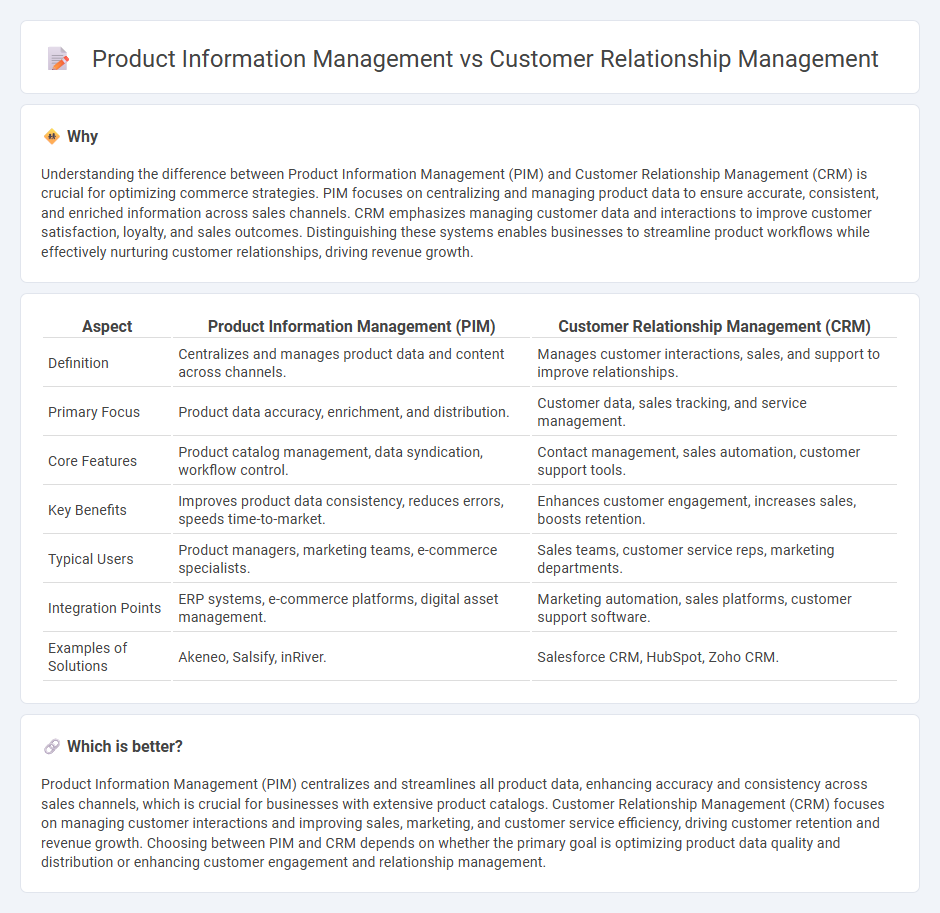
Product Information Management (PIM) centralizes and organizes detailed product data to ensure consistent and accurate information across multiple sales channels, enhancing inventory accuracy and boosting sales efficiency. Customer Relationship Management (CRM) focuses on managing customer interactions, tracking sales leads, and improving customer service to foster loyalty and increase revenue. Explore deeper insights into how PIM and CRM systems can optimize your commerce strategy.
Why it is important
Understanding the difference between Product Information Management (PIM) and Customer Relationship Management (CRM) is crucial for optimizing commerce strategies. PIM focuses on centralizing and managing product data to ensure accurate, consistent, and enriched information across sales channels. CRM emphasizes managing customer data and interactions to improve customer satisfaction, loyalty, and sales outcomes. Distinguishing these systems enables businesses to streamline product workflows while effectively nurturing customer relationships, driving revenue growth.
Comparison Table
| Aspect | Product Information Management (PIM) | Customer Relationship Management (CRM) |
|---|---|---|
| Definition | Centralizes and manages product data and content across channels. | Manages customer interactions, sales, and support to improve relationships. |
| Primary Focus | Product data accuracy, enrichment, and distribution. | Customer data, sales tracking, and service management. |
| Core Features | Product catalog management, data syndication, workflow control. | Contact management, sales automation, customer support tools. |
| Key Benefits | Improves product data consistency, reduces errors, speeds time-to-market. | Enhances customer engagement, increases sales, boosts retention. |
| Typical Users | Product managers, marketing teams, e-commerce specialists. | Sales teams, customer service reps, marketing departments. |
| Integration Points | ERP systems, e-commerce platforms, digital asset management. | Marketing automation, sales platforms, customer support software. |
| Examples of Solutions | Akeneo, Salsify, inRiver. | Salesforce CRM, HubSpot, Zoho CRM. |
Which is better?
Product Information Management (PIM) centralizes and streamlines all product data, enhancing accuracy and consistency across sales channels, which is crucial for businesses with extensive product catalogs. Customer Relationship Management (CRM) focuses on managing customer interactions and improving sales, marketing, and customer service efficiency, driving customer retention and revenue growth. Choosing between PIM and CRM depends on whether the primary goal is optimizing product data quality and distribution or enhancing customer engagement and relationship management.
Connection
Product Information Management (PIM) and Customer Relationship Management (CRM) systems are interconnected through their shared goal of enhancing customer experience and driving sales. PIM centralizes accurate product data, ensuring that CRM platforms deliver personalized, relevant information to customers throughout their buying journey. Integrating PIM with CRM enables businesses to synchronize product details with customer preferences, leading to improved marketing strategies and increased customer satisfaction.
Key Terms
Customer Data
Customer Relationship Management (CRM) systems centralize customer data including contact details, interaction history, and purchase behavior to enhance personalized marketing and improve client retention. Product Information Management (PIM) focuses on organizing and maintaining detailed product data, which supports accurate and consistent product information across multiple channels but does not prioritize individual customer insights. Explore the distinct roles of CRM and PIM in leveraging customer data to optimize business strategies.
Product Catalog
Product information management (PIM) centralizes and enriches product data, ensuring accurate and consistent product catalog content across multiple channels. Customer relationship management (CRM) focuses on managing customer interactions and sales processes but lacks detailed product catalog management capabilities. Explore how integrating PIM and CRM can optimize your product catalog and enhance the overall customer experience.
Personalization
Customer relationship management (CRM) systems centralize customer data to enhance personalization through targeted marketing, customer segmentation, and behavior analysis. Product information management (PIM) platforms organize and optimize product data to deliver consistent, detailed, and personalized product content across multiple channels. Discover how integrating CRM and PIM can elevate your personalization strategy.
Source and External Links
What is CRM (Customer Relationship Management)? - CRM is a combination of practices, strategies and technologies companies use to manage and analyze customer interactions and data throughout the customer lifecycle to improve service, retention, and sales growth, integrating data from multiple channels into one system for better insights and teamwork.
customer relationship management (CRM) - CRM is a set of integrated technologies used to document, track, and manage an organization's relationships and interactions with existing and potential customers, supporting sales, lead management, forecasting, and enhancing customer experience.
What is CRM? - CRM is a comprehensive software system involving sales, service, ecommerce, and marketing clouds plus a customer data platform to provide a complete customer profile and improve engagement, sales, loyalty, and profitability across all customer touchpoints.
 dowidth.com
dowidth.com